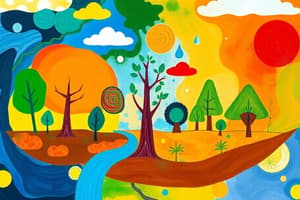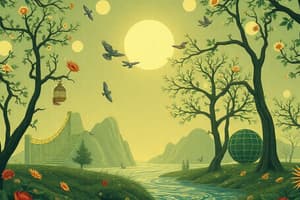Podcast
Questions and Answers
What is the primary product of cellular respiration alongside energy?
What is the primary product of cellular respiration alongside energy?
- Glucose
- Calcium carbonate
- Carbon dioxide (correct)
- Oxygen
What role do nitrogen-fixing bacteria play in the nitrogen cycle?
What role do nitrogen-fixing bacteria play in the nitrogen cycle?
- Converting ammonia into nitrogen gas
- Facilitating photosynthesis
- Decomposing organic matter
- Converting nitrogen gas into ammonia (correct)
How does excessive nitrogen addition affect ecosystems?
How does excessive nitrogen addition affect ecosystems?
- Increases biodiversity
- Leads to eutrophication (correct)
- Reduces soil nutrient levels
- Enhances photosynthesis in all plants
What is the largest reservoir of carbon on Earth?
What is the largest reservoir of carbon on Earth?
What is the primary gas exchanged during the process of combustion?
What is the primary gas exchanged during the process of combustion?
What process occurs when carbon dioxide is dissolved in ocean water?
What process occurs when carbon dioxide is dissolved in ocean water?
Which process helps to assimilate nitrogen into plants?
Which process helps to assimilate nitrogen into plants?
What role does photosynthesis play in the carbon cycle?
What role does photosynthesis play in the carbon cycle?
How does deforestation impact the carbon cycle?
How does deforestation impact the carbon cycle?
Which process is NOT part of the carbon cycle?
Which process is NOT part of the carbon cycle?
Why is carbon considered a crucial element for living organisms?
Why is carbon considered a crucial element for living organisms?
What effect does excess carbon dioxide have on the environment?
What effect does excess carbon dioxide have on the environment?
What is the primary method by which carbon is introduced into the food web?
What is the primary method by which carbon is introduced into the food web?
Which of the following components is NOT involved in the process of photosynthesis?
Which of the following components is NOT involved in the process of photosynthesis?
What is one consequence of the disruption of the carbon cycle by human activity?
What is one consequence of the disruption of the carbon cycle by human activity?
Flashcards
Carbon Cycle
Carbon Cycle
The movement of carbon between Earth, the atmosphere, and living things.
Photosynthesis
Photosynthesis
The process used by plants to convert sunlight, water, and carbon dioxide into glucose (sugar) and oxygen.
Respiration
Respiration
A chemical reaction that releases energy stored in food by breaking down glucose into carbon dioxide and water.
Combustion
Combustion
Signup and view all the flashcards
Dissolving
Dissolving
Signup and view all the flashcards
Deforestation
Deforestation
Signup and view all the flashcards
Greenhouse gases
Greenhouse gases
Signup and view all the flashcards
Global warming
Global warming
Signup and view all the flashcards
What is respiration?
What is respiration?
Signup and view all the flashcards
What is combustion?
What is combustion?
Signup and view all the flashcards
What is Nitrogen Fixation?
What is Nitrogen Fixation?
Signup and view all the flashcards
What is Nitrogen Assimilation?
What is Nitrogen Assimilation?
Signup and view all the flashcards
What is the ocean's role in the carbon cycle?
What is the ocean's role in the carbon cycle?
Signup and view all the flashcards
What is the Nitrogen Cycle?
What is the Nitrogen Cycle?
Signup and view all the flashcards
How do humans disrupt the Nitrogen cycle?
How do humans disrupt the Nitrogen cycle?
Signup and view all the flashcards
Study Notes
Matter Cycles: Carbon and Nitrogen
- Matter cycles are crucial for life on Earth, transporting and storing matter between the Earth, atmosphere, and living things. Essential elements like carbon and nitrogen are made available for living processes.
Carbon Cycle
- The carbon cycle involves the movement of carbon between these components. It is vital because human disruption of this cycle is linked to global warming.
- Carbon moves through different processes:
- Photosynthesis: Plants absorb CO2 from the air, incorporating it into their structures (glucose).
- Respiration: Organisms release CO2 into the atmosphere.
- Combustion: Burning of organic matter (e.g., fossil fuels) releases CO2.
- Dissolving: CO2 dissolves in water bodies.
- Carbon is fundamental to life's molecules (nucleic acids, proteins, etc.). Its unique electron configuration allows for complex molecular structures.
- Ocean as a Carbon Sink: The ocean absorbs CO2, forming carbonic acid. Over time, this can become limestone (a significant carbon reservoir). Excess CO2 leads to ocean acidification.
- Human Impact: Deforestation reduces CO2 absorption via photosynthesis, increasing atmospheric CO2 levels and contributing to global warming and climate change.
Nitrogen Cycle
- The nitrogen cycle moves nitrogen through Earth's systems. Nitrogen is essential for proteins and nucleic acids.
- Nitrogen Fixation: Atmospheric nitrogen must be converted into usable forms by organisms or lightning. This is typically performed by bacteria.
- Assimilation: Plants take up nitrogen from soil to form biomolecules, and this nitrogen passes through the food web.
- Nitrogen Recycling: When organisms die, nitrogen is released back into the environment for reuse in the cycle.
- Human Impact: Excess nitrogen from fertilizers can enter ecosystems and cause eutrophication (excess nutrient buildup leading to harmful algal blooms).
Comparing Carbon and Nitrogen Cycles
| Feature | Carbon Cycle | Nitrogen Cycle |
|---|---|---|
| Element Cycled | Carbon | Nitrogen |
| Key Processes | Photosynthesis, Respiration, Combustion, Dissolving | Fixation, Assimilation |
| Major Human Disruptions | Increased atmospheric CO2 (deforestation, burning fossil fuels) leading to global warming. | Eutrophication from excess fertilizer nitrogen. |
Studying That Suits You
Use AI to generate personalized quizzes and flashcards to suit your learning preferences.




